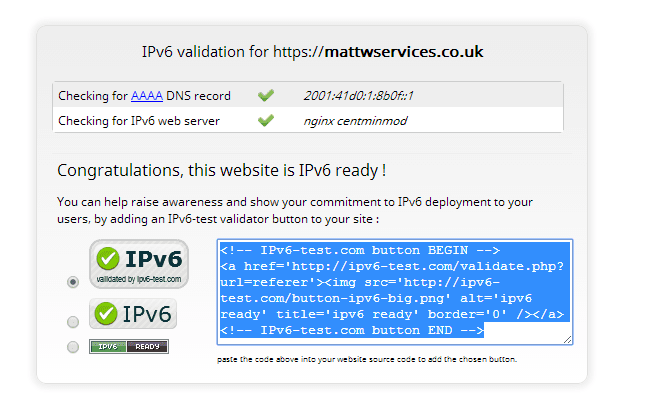Matt
Owner
As requested by @RoldanLT
So, my server was given a /64 range of IPV6 addresses. I only need a couple of these.
This actually gives me
That's a LOT of addresses!
Now, to assign these to your NIC card in CentOS, you need to add these to ethernet interface
This is the default config that my server came with, and only 1 had IPV6 address configured
You need to add the additional addresses as IPV6ADDR_SECONDARIES
I'm going to use the first 4 in the range
Restart your NIC card /etc/init.d/network restart
You will now see those addresses configured
You now need to make sure you application can use those addresses.
For nginx built with Centminmod, you need to edit the centmin.sh file and set IPV6 to YES
Now re-build nginx.
Once that is done, you can assign an IPv6 address to the site(s)
For the config files in /usr/local/nginx/conf/conf.d/ in your server block:
Restart nginx
You will now see the listen being posted on that IP address using netstat
Then, you need to add a DNS entry for it

You should then be ready to test the site
http://ipv6-test.com/validate.php

So, my server was given a /64 range of IPV6 addresses. I only need a couple of these.
Code:
2001:41D0:1:8B0f::/64
Code:
Start Range: 2001:41d0:1:8b0f:0:0:0:0
End Range: 2001:41d0:1:8b0f:ffff:ffff:ffff:ffff
No. of host: 18446744073709551616Now, to assign these to your NIC card in CentOS, you need to add these to ethernet interface
Code:
/etc/sysconfig/network-scripts/ifcfg-eth0This is the default config that my server came with, and only 1 had IPV6 address configured
Code:
DEVICE=eth0
BOOTPROTO=static
IPADDR=91.121.86.15
NETMASK=255.255.255.0
ONBOOT=yes
GATEWAY=91.121.86.254
IPV6INIT=yes
IPV6_AUTOCONF=no
IPV6ADDR=2001:41D0:1:8B0f::1/64You need to add the additional addresses as IPV6ADDR_SECONDARIES
I'm going to use the first 4 in the range
Code:
DEVICE=eth0
BOOTPROTO=static
IPADDR=91.121.86.15
NETMASK=255.255.255.0
ONBOOT=yes
GATEWAY=91.121.86.254
IPV6INIT=yes
IPV6_AUTOCONF=no
IPV6ADDR=2001:41D0:1:8B0f::1/64
IPV6ADDR_SECONDARIES="2001:41d0:1:8b0f::2/64 \
2001:41d0:1:8b0f::3/64 \
2001:41d0:1:8b0f::4/64"Restart your NIC card /etc/init.d/network restart
You will now see those addresses configured
Code:
[root@host ~]# ifconfig
eth0 Link encap:Ethernet HWaddr 4C:72:B9:4E:DE:B8
inet addr:91.121.86.15 Bcast:91.121.86.255 Mask:255.255.255.0
inet6 addr: 2001:41d0:1:8b0f::4/64 Scope:Global
inet6 addr: 2001:41d0:1:8b0f::3/64 Scope:Global
inet6 addr: 2001:41d0:1:8b0f::2/64 Scope:Global
inet6 addr: 2001:41d0:1:8b0f::1/64 Scope:Global
inet6 addr: fe80::4e72:b9ff:fe4e:deb8/64 Scope:Link
UP BROADCAST RUNNING MULTICAST MTU:1500 Metric:1
RX packets:34594219 errors:0 dropped:0 overruns:0 frame:0
TX packets:50375374 errors:0 dropped:0 overruns:0 carrier:0
collisions:0 txqueuelen:1000
RX bytes:30177374559 (28.1 GiB) TX bytes:61721279662 (57.4 GiB)
Interrupt:20 Memory:fe500000-fe520000
lo Link encap:Local Loopback
inet addr:127.0.0.1 Mask:255.0.0.0
inet6 addr: ::1/128 Scope:Host
UP LOOPBACK RUNNING MTU:65536 Metric:1
RX packets:26110940 errors:0 dropped:0 overruns:0 frame:0
TX packets:26110940 errors:0 dropped:0 overruns:0 carrier:0
collisions:0 txqueuelen:0
RX bytes:43405433324 (40.4 GiB) TX bytes:43405433324 (40.4 GiB)You now need to make sure you application can use those addresses.
For nginx built with Centminmod, you need to edit the centmin.sh file and set IPV6 to YES
Code:
NGINX_IPV='y' #NGINX IPV6 compile support for unattended mode onlyNow re-build nginx.
Once that is done, you can assign an IPv6 address to the site(s)
For the config files in /usr/local/nginx/conf/conf.d/ in your server block:
Code:
server {
listen 443 ssl spdy;
listen [2001:41d0:1:8b0f::1]:443 ssl spdy;
server_name mattwservices.co.uk;
keepalive_timeout 30;Restart nginx
You will now see the listen being posted on that IP address using netstat
Code:
[root@host conf.d]# netstat -an | grep ::1
tcp 0 0 2001:41d0:1:8b0f::1:443 :::* LISTENThen, you need to add a DNS entry for it

You should then be ready to test the site
http://ipv6-test.com/validate.php


